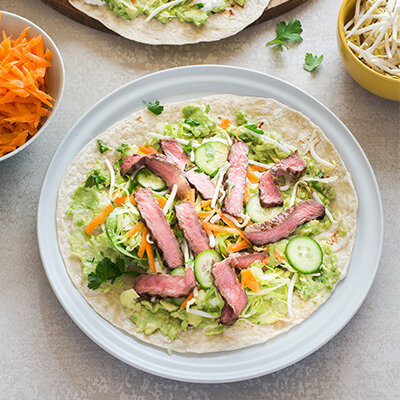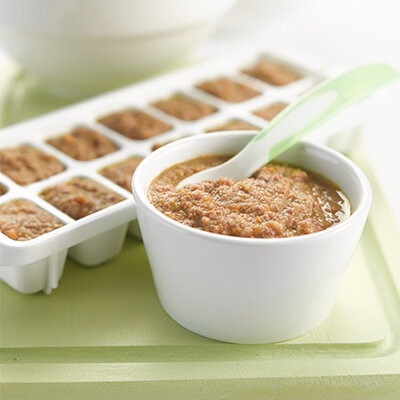HOME > NUTRITION > FACTS & ADVICE > GROWING HEALTHY BABIES & TODDLERS
Practical tips and iron-rich meal ideas for babies and toddlers.
Scroll down to read more about first foods for baby.
This advice is provided as general tips, and does not replace the advice from your registered healthcare professional. This information pertains to complementary foods offered from around 6 months, and does not replace advice around breastfeeding. For advice on when your baby is ready for complementary foods, visit the Ministry of Health’s website.
Have you ever looked at your little one in the morning and thought they had grown overnight? Childhood is a period of rapid growth and development and good nutrition plays an integral role in ensuring your child remains healthy, now and into adulthood.
In the early years, feeding babies and toddlers is a new time of discovery – for their taste buds, and your role modelling. They have little tummies, so every bite counts when it comes to nourishing them with nutritious foods.
Feeding babies
Complementary foods are those that are introduced whilst baby is still breast or formula fed. Complementary foods become important from around 6 months of age as baby’s stores of iron and zinc start to fall, and breast milk or formula cannot fulfil nutrient requirements alone.
“From 6 months of age, complementary iron-rich foods are vital for baby.”
When complementary feeding begins, there are some key foods to start with in a smooth purée particularly those that are iron-rich, eventually building up in texture and variety to eating family foods by the age of 1. Below is a general guide adapted from the Ministry of Health Food and Nutrition Guidelines for Healthy Infants and Toddlers (0-2 years) which ensure a range of vitamins, minerals and nutrients to meet the growth and development needs of your baby.
Age of introduction provided as a guide only. Reference: Ministry of Health. 2021. Healthy Eating Guidelines for New Zealand Babies and Toddlers (0–2 years old). Wellington: Ministry of Health.
The textures journey
From around 6 months of age, complementary foods should be introduced in a smooth purée form, progressing on to mashed/lumpy when baby is around 6.5 -7 months, minced and finely chopped foods for babies from 8 months, and eventually to a toddler/family meal from around 12 months. Here’s what Shepherd’s Pie looks like across the stages:
For information on baby led weaning, see the Ministry of Health website.
Toddlers
By the time your little one has had their first birthday, they should be offered a variety of nutritious foods that the family are enjoying from the four food groups outlined by the Ministry of Health:
Vegetables and fruit
Breads and cereals, including some wholemeal
Milk and milk products or suitable alternatives
Lean meat, poultry, seafood, eggs, legumes, nuts and seeds.*
*Do not give small hard foods like whole nuts and large seeds until children are at least five years old.
For more information on fussy or picky eating visit this website.
How much iron do we need each day?
Why is iron so critical in the early years?
Did you know?
Between birth and two years, the human brain grows to 80% of its adult size.
At 7 months, a baby needs more iron than their dad.
Iron is deposited in the brain - it is part of the brain structure and is therefore an essential nutrient for mental development.
Babies need a lot of iron because they are growing so rapidly. In the first 12 months, their birth weight triples.
Iron helps your toddler by carrying oxygen to their brain and muscles, supporting growth and brain development, while releasing energy from the food they eat.
8 out of 10 toddlers in New Zealand don’t meet the daily intake of dietary iron.
14% of New Zealand children under the age of 2 are iron deficient
Iron and babies
Babies need a lot of iron because they are growing so rapidly, in the first 12 months their birth weight can triple. Babies have enough iron stored from birth to last around 6 months. After this their iron stores are running out and milk feeds alone will not give them enough iron. From around six months infants are introduced to solid and complementary foods, these need to be iron-rich to meet their daily requirements of 11mg of iron a day.
Signs your baby or toddler could be low in iron – talk to your GP or Plunket Nurse if you are concerned:
Recurrent infections
Grumpy and irritable
Tired and lethargic
Difficulty sleeping
Pale
Feels the cold
Reduced appetite
Reduced weight gain
Digestive problems
What other nutrients does New Zealand grass-fed beef and lamb have that can help with growth and development?
Zinc is essential for many functions, including growth, brain development, immune and sensory function, antioxidant protection and behaviour. Protein is made up of amino acids which form neurotransmitters, and these neurotransmitters allow brain cells to communicate with each other. Phosphorus as well as B vitamins, including B12, B6, B3, B2, and B1 all contribute to the general health and development of your child.
Recipes for your little one
Have you seen our baby and toddler recipes? We have something for everyone, from starting solids to recipes even the tweens will enjoy. Check them out here or click on one of our favourites below:
More information
Check out our resident’s blog on Are our babies eating healthy enough?
Looking after yourself as a parent is important too, check out one of our team mums tips here
Fact sheet – Iron for infants and children
References
Ministry of Health. 2008. Food and Nutrition Guidelines for Healthy Infants and Toddlers (Aged 0-2): A background paper (4th Ed). Wellington: Ministry of Health.
Ministry of Health. 2021. Healthy Eating Guidelines for New Zealand Babies and Toddlers (0–2 years old). Wellington: Ministry of Health.
Ministry of Health. 2020. Eating and Activity Guidelines for New Zealand Adults: Updated 2020. Wellington: Ministry of Health.
National Health and Medical Research Council (NHMRC). Nutrient Reference Values for Australia and New Zealand including Recommended Dietary Intakes. Canberra: NHMRC, Wellington: Ministry of Health, 2006.
Wall, CR et al. (2008). Ethnic variance in iron status: is it related to dietary intake? Public Health Nutr 12 (9):1413-1421.
Grant, CC et al. (2007). Population prevalence and risk factors for iron deficiency in Auckland, New Zealand. J Paediatr Child Health 43: 532-538.










